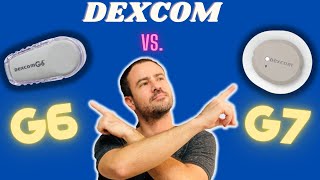Dexcom G7 vs G6: Choosing the Right Continuous Glucose Monitor
Living with diabetes requires precision and accuracy in managing your glucose levels. The choice between Dexcom G7 and Dexcom G6 can significantly impact your daily life. In this comprehensive guide, we’ll break down the differences and help you make an informed decision.
Understanding the Evolution: Dexcom G7 and G6
Continuous Glucose Monitoring (CGM) technology has come a long way. Dexcom, a prominent player in the CGM industry, has introduced the G7 as the successor to the G6. Let’s explore the key aspects:

Enhanced Form Factor and Wearability
The Dexcom G7 boasts a more discreet and comfortable design. Its slim profile and easy-to-wear sensor are welcome improvements for users who value comfort and discretion.
Extended Wear and Sensor Life
With the G7, Dexcom has extended sensor life to 14 days, providing you with more data and fewer sensor changes. The G6, in contrast, requires a sensor change every 10 days.
Calibration-Free Convenience
One notable feature of the G7 is its calibration-free setup. Users no longer need to calibrate the sensor with fingerstick measurements, streamlining the monitoring process.
Comparing Accuracy: Dexcom G7 vs G6
Accurate glucose monitoring is paramount for effective diabetes management. The accuracy of a CGM system can be a deciding factor in choosing between Dexcom G7 and G6:
Advanced Accuracy with G7
Dexcom G7 introduces the next-generation sensor, which is designed for enhanced accuracy. It offers improved performance, particularly in the hypoglycemic range, making it a strong choice for those who need precise monitoring.
G6’s Proven Accuracy
The G6, while reliable, may not match the enhanced accuracy of the G7. It remains a solid choice, especially for those accustomed to its dependable performance.
Connectivity and Data Sharing
In our interconnected world, CGMs that offer seamless data sharing and remote monitoring can be a game-changer for both patients and caregivers:
G7: Bluetooth-Enabled Convenience
Dexcom G7 comes equipped with Bluetooth, enabling data sharing with smartphones and compatible devices. It’s a step forward in connectivity, making remote monitoring and sharing data with healthcare providers more convenient.
G6’s Connectivity
The G6, too, offers connectivity options, allowing data sharing, but the G7’s Bluetooth capabilities provide an edge in this regard.
User Experience and Convenience
User experience plays a significant role in CGM adoption and adherence. Here’s how the G7 and G6 compare in terms of user-friendliness:
G7’s Ease of Use
Dexcom G7’s calibration-free setup and extended sensor life contribute to a more user-friendly experience. Users appreciate the simplified process and the freedom from calibration routines.
G6’s Proven Reliability
The G6, known for its reliability, remains a straightforward and user-friendly choice. It has been a trusted companion for many users in their diabetes management journey.
Making Your Decision: Dexcom G7 vs G6
The choice between Dexcom G7 and G6 is not a one-size-fits-all decision. It hinges on your specific needs, preferences, and priorities. To make the right choice, consider the factors we’ve discussed, along with any personal considerations that matter most to you.
As you embark on your journey to select the ideal continuous glucose monitor, rest assured that both the G7 and G6 offer valuable features and advantages. Ultimately, your choice will be a reflection of your unique requirements in managing your diabetes.
Stay Informed and Empowered
Stay informed, stay empowered, and stay on top of your glucose management. Whether you choose the Dexcom G7 or the G6, remember that these CGM systems are powerful tools in your diabetes management toolkit.
Dexcom G7 vs G6 FAQs
1. What are the key differences between Dexcom G7 and G6?
The primary differences include enhanced accuracy, extended sensor life, and calibration-free setup in Dexcom G7, while Dexcom G6 offers proven reliability and user-friendly features.
2. Is Dexcom G7 more accurate than G6?
Yes, Dexcom G7 is designed for enhanced accuracy, particularly in the hypoglycemic range, making it a strong choice for those who prioritize precise glucose monitoring.
3. What is the sensor life of Dexcom G7 and G6?
Dexcom G7 offers an extended sensor life of 14 days, while G6 sensors need replacement every 10 days.
4. Can I use Dexcom G7 with both iOS and Android devices?
Yes, Dexcom G7 is compatible with a broader range of devices, including both iOS and Android platforms.
5. Do I need to calibrate the Dexcom G7 sensor?
No, Dexcom G7 offers a calibration-free setup, eliminating the need for manual calibrations.
6. What is the connectivity difference between Dexcom G7 and G6?
Dexcom G7 comes equipped with Bluetooth for data sharing, offering more convenient connectivity. G6 also supports data sharing but without Bluetooth.
7. Are there cost differences between Dexcom G7 and G6?
The cost may vary, and it’s essential to weigh features and benefits against the price to determine the best value for your needs.
8. Can I get insights from real-world users of Dexcom G7?
Yes, we’ve gathered feedback from G7 users to provide real-world insights into their experiences.
9. What devices are compatible with Dexcom G6?
Dexcom G6 is compatible with various devices, making it a versatile choice for different users.
10. How do I consult with my healthcare provider about choosing between Dexcom G7 and G6?
It’s essential to consult with your healthcare provider, who can offer personalized guidance based on your unique diabetes management needs.
Conclusion:
The decision between Dexcom G7 and G6 is a significant one, as it directly impacts how you monitor and manage your glucose levels. We’ve navigated through the essential aspects of these continuous glucose monitoring systems to help you make an informed choice. The differences in connectivity, device compatibility, and cost should be considered alongside the core features. Furthermore, real-world user feedback provides valuable insights into what to expect when using either system.




